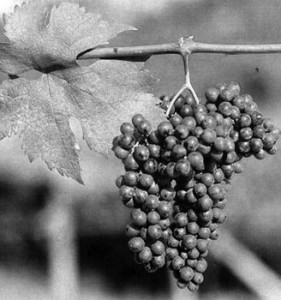This year winter does not seem to want to let go of its grasp over us. Nevertheless, spring temperatures will be here soon. With warmer temperatures, thoughts turn towards outdoor eating, picnics, bbq’s, locally grown foods, etc.. In terms of which wines to drink, we tend to gravitate towards white and rosé wines. A reader recently asked me which wines I enjoy in the summer. In this month’s column, I like to discuss a wine which in my estimation does not get enough press: Lambrusco.
 Lambrusco has been mentioned throughout history. In ancient times, Virgil, Pliny and Cato commented on the volume of wine that this grape produced. Historical records in the 14th century have Andrea Baci chief physician to the pope, discussing the cultivation of this vine. Its name derives from the Latin labrum meaning edge, and bruscum meaning cultivated field. The Romans noticed that these wild vines often grew beside their farms.
Lambrusco has been mentioned throughout history. In ancient times, Virgil, Pliny and Cato commented on the volume of wine that this grape produced. Historical records in the 14th century have Andrea Baci chief physician to the pope, discussing the cultivation of this vine. Its name derives from the Latin labrum meaning edge, and bruscum meaning cultivated field. The Romans noticed that these wild vines often grew beside their farms.
Lambrusco is a wine and also a red wine grape. It is produced in diverse styles. It is grown primarily in Emilia-Romagna (in the provinces of Modena, Parma and Reggio Emilia) and some is also produced in Lombardia (province of Mantua). In fact, there are six varieties of Lambrusco: Lambrusco Grasparossa, Lambrusco Maestri, Lambrusco Marani, Lambrusco Montericco, Lambrusco Salamino and Lambrusco Sorbara. Of these six, the Lambrusco Salomino is the most common. Typically, most Lambrusco is produced in a slightly sparkling manner; which in Italian is referred to as frizzante. This is achieved using the Charmat process whereby secondary fermentation takes place in huge stainless steel tanks. Lambrusco can range from light to full-bodied. In terms of sweetness, it can range from sweet (amabile) to dry (secco). All of these factors are determined by the wine making practices and varieties of Lambrusco used in the different regions where it is produced.
If it is partially fermented the result will be sweet. A sweet Lambrusco can also be produced by blending it with the Ancellotta grape which in itself produces a sweet wine. Those of you that are a little older will remember a very sweet Lambrusco in the 1970’s called Riunite. They had a very successful TV commercial ending with the phrase, Riunite on ice…that’s nice! Millions of cases were sold back then in the USA. Unfortunately for Lambrusco, Riunite was labeled as a poor quality, overly sweet fizzy wine. Today, with improvements in viticultural practices and winemaking in general, Lambrusco has improved in quality since the days of Riunite on ice! .
What can one expect from this grape? Visually, the wine can be from a very light ruby red to opaque. On the nose you typically have very fragrant aromas varying from strawberry to floral. On the palate, given its sparkling nature, it is zesty, medium to high acidity, medium-bodied with fruity berry flavours. Typically the finish is slightly bitter. It is typically low in alcohol. Most are around 11% or lower which is just perfect for a summer picnic.
Speaking of picnics, this is a perfect picnic wine. The drier versions go well with grilled meats, deli meats and parmiggiano-reggiano cheese. The more fruity versions are perfect with strawberries or ice cream or on their own. A good example of the fruity version is the CHIARLI CASTELVELTRO LAMBRUSCO. It is light in alcohol at only 7.8%. This is available at the LCBO and is only $9.95 a bottle. An example of a drier version of Lambrusco is CASALI BORGO DEL BOIARDO REGGIANO LAMBRUSCO ROSATO SECCO 2011. It is made with 50% Lambrusco Salamino, 35% Lambrusco Marani, and 15% Lambrusco Sorbara. It is also available at the LCBO at $14.95 a bottle. This is a more complex wine than the Chiarli Casteveltro offering. It is more opaque in colour than the sweeter Lambrusco. On the nose, you have ripe cherries. On the palate you have a very balanced dry wine between its crisp acidity and fruitiness. I loved it with pasta and fagioli!
Lambrusco in the last 10 years has made quite a comeback in foreign markets. Gone mostly are the days where the name Lambrusco meant sweet industrial type wines. With so many diverse styles, it is a wonderful food wine. I am sure that it will match well with the all the delicious foods that we will be enjoying at many Italian picnics this summer!
Salute!
If you have any questions or suggestions for future columns, please contact me at vinumbonumest@yahoo.com.
Domenico Cellucci is a wine consultant and educator and is a graduate of Algonquin College’s Sommelier Program. He puts on food and wine matching events in the national capital area. He has visited wineries and vineyards in Italy, France, British Columbia, Ontario and the United States